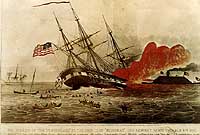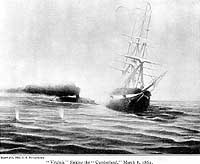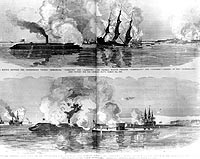
At mid-day on 8 March 1862, CSS Virginia (formerly USS Merrimack, and persistently mid-identified by that name or as "Merrimac") steamed down the Elizabeth River from Norfolk and entered Hampton Roads. It was the newly converted ironclad's trial trip, a short voyage that would deeply influence naval opinion at home and abroad.
Anchored on the opposite side of Hampton Roads were five major Union warships: the frigate Congress and large sloop of war Cumberland off Newport News, and the frigates St. Lawrence, Minnesota and Roanoke a few miles to the east, off Fortress Monroe. All were powerful conventional wooden men o'war. Minnesota and Roanoke, of the same type as the pre-war Merrimack, had auxiliary steam propulsion, but the other three were propelled by sails alone, and thus were at the mercy of wind conditions and the availability of tugs. As Virginia crossed the Roads, looking (as one witness described her) "like the roof of a very big barn belching forth smoke as from a chimney on fire", the Union ships called their crews to quarters and prepared for action. Turning west, the Confederate ironclad shrugged off steady fire from ships and shore batteries as she steamed past the Congress. Firing her heavy cannon into both ships, she pushed her ram into Cumberland's starboard side. The stricken ship began to sink, though her gun crews kept up a heavy fire as she went down. In the words of one of Cumberland's enemies, "No ship was ever fought more gallantly."
Virginia backed clear, tearing off most of her iron ram, and slowly turned toward the Congress, which had gone aground while trying to get underway. Confederate gunners put several raking shells into the frigate's hull, and maintained a relentless fire as they came alongside. After an hour's battle, in which Congress' crew suffered heavy casualties, she raised the white flag of surrender. As the Confederates began to take off her crew, several men on both sides were hit by gunfire from ashore, among them the Virginia's Commanding Officer, Captain Franklin Buchanan, who ordered Congress set afire with hot shot. She blazed into the night, exploding as the fire reached her powder magazines about two hours after midnight.
Virginia had meanwhile made a brief demonstration in the direction of the big steam frigate Minnesota, which had also gone aground. However, with the day's light about to fade, the ironclad turned back toward the southern side of Hampton Roads and anchored. Though two of her guns had their muzzles shot off and most external fittings were swept away or rendered useless, she had dramatically demonstrated the horrible vulnerability of unarmored wooden warships when confronted with a hostile ironclad, and was still battleworthy. Her casualties, less than two-dozen, were removed and command passed from the injured Buchanan to Lieutenant Catesby ap R. Jones, who would take Virginia out the next day to deal with the Minnesota.
This page features images of the battle between CSS Virginia and the Federal warships Cumberland and Congress, 8 March 1862.
For additional pictorial coverage of this action, see:
For other views of the ships involved, see:
For views of the acting commanding officers of Cumberland and Congress, and of another officer who lost his life in this action, see:
| If you want higher resolution reproductions than the digital images presented here, see: "How to Obtain Photographic Reproductions." |
Click on the small photograph to prompt a larger view of the same image.
|
Photo #: 80-G-K-17106 (Color) "Iron versus Wood -- Sinking of the Cumberland by the Merrimac. In Hampton Roads, March 8, 1862." Oil painting by Edward Moran (1829-1901), depicting CSS Virginia (ex-USS Merrimack) ramming USS Cumberland in the teeth of a broadside from the wooden warship. This painting was presented to the U.S. Naval Academy in 1941 by Paul E. Sutro, of Philadelphia. It was photographed by Taggart in December 1953. Official U.S. Navy Photograph, now in the collections of the National Archives. Online Image: 66KB; 740 x 505 pixels Reproductions of this image may also be available through the National Archives photographic reproduction system. |
 |
|
Photo #: NH 64088-KN (Color) USS Cumberland sunk by CSS Virginia (ex-USS Merrimack), 8 March 1862 Colored lithograph by Currier and Ives, 1862, entitled "The Sinking of the 'Cumberland' by the Iron Clad 'Merrimac', off Newport News, Va., March 8th 1862. 'Cumberland' went down with all her Flags flying: -- destroyed, but not conquered. Her gallant Commander Lieut. Morris calling to his crew 'Given them a Broadside boys, as she goes'." Courtesy of the Beverly Robinson Collection, U.S. Naval Academy Museum, Annapolis, Maryland. U.S. Naval Historical Center Photograph. Online Image: 119KB; 740 x 525 pixels |
 |
|
Photo #: NH 59215 CSS Virginia rams and sinks USS Cumberland, 8 March 1862 Halftone reproduction of an artwork, copyright 1906 by G.S. Richardson. The original print was presented by the Norfolk Naval Shipyard. U.S. Naval Historical Center Photograph. Online Image: 119KB; 740 x 630 pixels |
 |
|
Photo #: NH 59212 CSS Virginia rams USS Cumberland, 8 March 1862 Halftone reproduction of an artwork, published in Fiveash, "Virginia-Monitor Engagement", Norfolk, Va., 1907. U.S. Naval Historical Center Photograph. Online Image: 98KB; 740 x 590 pixels |
 |
|
Photo #: NH 59222 "The Rebel Steamer 'Merrimac' running down the Frigate 'Cumberland' off Newport News" Line engraving, published in the "Harper's Weekly", January-June 1862, pages 184-185, depicting CSS Virginia (ex-USS Merrimack) ramming USS Cumberland, 8 March 1862. USS Congress and the bow of a Confederate gunboat are shown at right. U.S. Naval Historical Center Photograph. Online Image: 80KB; 740 x 315 pixels |
 |
|
Photo #: NH 2048 CSS Virginia sinking USS Cumberland, 8 March 1862 Oil painting by an unidentified "Eyewitness". Collection of President Franklin D. Roosevelt, 1936. U.S. Naval Historical Center Photograph. Online Image: 122KB; 740 x 505 pixels |
 |
|
Photo #: NH 59224 Two views of CSS Virginia in action, 8 & 9 March 1862 Line engravings published in "The Soldier in Our Civil War", Volume 1, pages 246-47. The upper view depicts the 8 March 1862 action off Newport News, Virginia, in which Virginia sank USS Cumberland and set USS Congress afire. The lower view depicts the battle between Virginia and USS Monitor in Hampton Roads on 9 March 1862. U.S. Naval Historical Center Photograph. Online Image: 101KB; 740 x 615 pixels |
 |
|
Photo #: NH 65698 Sinking of USS Cumberland by CSS Virginia, 8 March 1862 Line engraving published in "Leslie's Weekly", circa 1862, depicting the scene on board the Cumberland as she went down off Newport News, Virginia, with her crew still firing on the Confederate ironclad. U.S. Naval Historical Center Photograph. Online Image: 138KB; 740 x 485 pixels |
 |
For additional pictorial coverage of this action, see:
For other views of the ships involved, see:
For views of the acting commanding officers of Cumberland and Congress, and of another officer who lost his life in this action, see:
| If you want higher resolution reproductions than the digital images presented here, see: "How to Obtain Photographic Reproductions." |
Page made 29 May 2001
Links added 29 June 2001